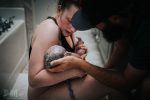According to the CDC, about 11,000 babies are born in the U.S. every day. If anyone in your family or group is of childbearing age, you might want to think about preparing for an out-of-hospital birth. Most people have never witnessed a “natural” or med-free birth. Therefore, they have no idea what natural birth looks like or how to prepare for it.
In Part 1, I spoke about the importance of the mother’s psyche in childbirth and also about the sphincter law that applies to childbirth. We began the topic of Preparing for Birth with suggestion for books, such as Ina May Gaskin’s books, Spiritual Midwifery and her Guide to Childbirth. Now, let’s look further at what else is needed.
Build Birth Team
As the second step in your preps, build your birth team. An educated and confident birth team can drastically improve birth outcomes. This means both parents, any aid available (doctor, OB, midwife, nurse, doula, et cetera) and anyone invited into the birth room during labor and delivery need to be on the same page. The birthing woman needs to feel safe and must trust her helpers. She requires encouragement, empathy, and the utmost respect from anyone who is invited into her birth space. You must protect her from anyone who is negative or untrusting of your plan. If she feels threatened or fearful, even before the onset of labor, these feelings can emerge during labor and delivery, possibly hindering labor progression.
A Place Where Calm and Confidence Reign
I encourage you to create a place where calm and confidence reign instead of anxiety and fear. This starts early in pregnancy. Start prepping for birth, including prenatal vitamins, medical gear, nourishing meals, proper clothing, baby items, et cetera. Just knowing that these preparations have been made will eliminate a great number of fears for the birthing woman. Consider packing enough for multiple children and multiple births.
Finally, watch, or download for future reference if the grid goes down, a few natural home births on Youtube. Many of these videos are professionally created by birth photographers and are tastefully made. Once you witness for yourself what natural birth can look like, you will already feel more confident in your preparations.
Labor and Delivery
During labor and birth, the birthing woman is in charge. Likely, she will be in the most pain she has ever experienced, with little hope for relief. If you are invited into her birthing space, you are there for her needs. I can not tell you how many times that I have witnessed family members loudly making jokes about birth or making selfish decisions, disrespecting the birthing woman and her team. I have witnessed these interruptions create an incredibly stressful atmosphere for birth. I’d encourage you to only allow necessary personnel into the birth room.
Offer Support
 Additionally, offer support. Hot and cold compresses on the sacrum (tailbone), as well as firm continuous pressure on the hips during the contraction can relieve a lot of pain. Take one contraction at a time; encourage her that she only has to focus on getting through the next contraction and not to focus on labor as a whole. Allow her to rest between the contractions; offer water or juice or a cool cloth. Don’t ask her questions during contractions, especially in the active phase. She may moan or hum as the pain intensifies, which is normal and encouraged.
Additionally, offer support. Hot and cold compresses on the sacrum (tailbone), as well as firm continuous pressure on the hips during the contraction can relieve a lot of pain. Take one contraction at a time; encourage her that she only has to focus on getting through the next contraction and not to focus on labor as a whole. Allow her to rest between the contractions; offer water or juice or a cool cloth. Don’t ask her questions during contractions, especially in the active phase. She may moan or hum as the pain intensifies, which is normal and encouraged.
Long, Slow Breathing During Intense Part of Birth
As labor progresses and the woman begins feeling the uncontrollable urge to push, similar to having a bowel movement, she can easily become fearful, as this is the most intense part of birth. The baby is now slowly descending passed the cervix and is in the birth canal or vagina. This feeling is incredibly intense and causes many women to hyperventilate. Encourage long slow breaths and remind her how well she is doing. She should only try to push or bear down during a contraction, not between. By doing this, she is effectively working with her body to slowly bring baby down the birth canal. This process takes time, and sometimes a lot of it, possibly hours.
Position That is Comfortable
 I should add, she may push in whatever position feels comfortable. She is not required to be on her back with her knees pulled to her chest. While this is a very effective way to push, there are many other positions that encourage easy descent, including squatting, sitting on the toilet, using a birth stool, or even relaxing in a bath of warm, soap-free water.
I should add, she may push in whatever position feels comfortable. She is not required to be on her back with her knees pulled to her chest. While this is a very effective way to push, there are many other positions that encourage easy descent, including squatting, sitting on the toilet, using a birth stool, or even relaxing in a bath of warm, soap-free water.
Soon you will begin to see the baby’s head. You can offer warmed coconut oil for lubrication and a warmed washcloth to the vaginal opening for relief. As the baby’s head begins to crown, remind the mother to push very slowly to allow the perineum, or skin between the vaginal opening and anus, to stretch. Allowing the head to emerge slowly will significantly reduce tearing.
Again, I am not a doctor, but if there is some minor tearing, which is very normal and usually heals quickly, dried seaweed is a great way to stop blood flow. If the tear is significant, stitches may be needed. Never cut the perineum to prevent tearing. According the the American Congress of Obstetricians and Gynecologists or ACOG, episiotomies are more damaging to the body than tearing naturally and have no significant benefit to normal physiological births. Additionally, witch hazel is a great herb for healing a sore perineum.
Allow Time for Mom and Baby to Bond
 Once the baby is born, allow at least an hour for mom and baby to bond and at least a week before others visit the newborn. Especially in a survival situation, cleanliness is of the utmost importance. Only the child’s immediate family and any medical personnel should hold the baby, in order to reduce transmission of germs or diseases, including radiation or fall-out if nuclear war has occurred.
Once the baby is born, allow at least an hour for mom and baby to bond and at least a week before others visit the newborn. Especially in a survival situation, cleanliness is of the utmost importance. Only the child’s immediate family and any medical personnel should hold the baby, in order to reduce transmission of germs or diseases, including radiation or fall-out if nuclear war has occurred.
After the Birth
 After the birth, the baby will still be connected to the yet-to-be detached placenta via the umbilical cord. The placenta is still inside and is slowly detaching from the uterus. As much as one third of the baby’s blood is still in the placenta; do not clamp or cut the cord until the cord is completely white or you no longer feel a pulse in the cord. Soon, the mother will feel the urge to push and the placenta will be born. Do not pull on the cord to try to remove the placenta, as the placenta may not be fully detached and can cause internal bleeding.
After the birth, the baby will still be connected to the yet-to-be detached placenta via the umbilical cord. The placenta is still inside and is slowly detaching from the uterus. As much as one third of the baby’s blood is still in the placenta; do not clamp or cut the cord until the cord is completely white or you no longer feel a pulse in the cord. Soon, the mother will feel the urge to push and the placenta will be born. Do not pull on the cord to try to remove the placenta, as the placenta may not be fully detached and can cause internal bleeding.
Also, encourage breastfeeding, as breastfeeding in itself causes the body to produce oxytocin, which helps stop bleeding through the contracting of the uterus. It is normal for her to feel weak contractions during breastfeeding in the first couple of weeks postpartum. Additionally, the first milk produced (colostrum) is a thick and yellow milk produced in the first three days postpartum, made specifically to nourish and build the newborn’s immune system. This milk is vital for a healthy start to life, especially in a survival situation.
The Placenta
 Additionally, do not dispose of the placenta. The placenta is loaded with millions of stem cells, iron, and healing nutrients that are vital to postpartum healing and, through anecdotal evidence, can even promote a better milk supply, reduce bleeding, and reduce the risk of postpartum depression. Almost every land mammal consumes the placenta after birth, which tells us there is something important within the biochemistry of consuming it. While this may seem “gross” or taboo, more and more modern women are choosing to consume their own placenta through placenta encapsulation or other method of consumption. There are many ways that women today are consuming their placentas post-birth, and I’d encourage you to do a little digging, as this organ may be exactly what is needed for healing in a survival situation.
Additionally, do not dispose of the placenta. The placenta is loaded with millions of stem cells, iron, and healing nutrients that are vital to postpartum healing and, through anecdotal evidence, can even promote a better milk supply, reduce bleeding, and reduce the risk of postpartum depression. Almost every land mammal consumes the placenta after birth, which tells us there is something important within the biochemistry of consuming it. While this may seem “gross” or taboo, more and more modern women are choosing to consume their own placenta through placenta encapsulation or other method of consumption. There are many ways that women today are consuming their placentas post-birth, and I’d encourage you to do a little digging, as this organ may be exactly what is needed for healing in a survival situation.
Conclusion
I have been a doula for several years now and have witnessed nearly 50 births, all of which were incredibly psychological and even spiritual. The homes and birth suites all exuded some type of social atmosphere, often times directly related to the attitude of the birth team and care providers. I have witnessed labor completely halt due to fear, and I’ve seen a woman dilate from 3cm to 10cm in 30 minutes because her husband expressed invaluable encouragement, thankfulness, and love during a difficult contraction. As humans, we thrive off encouragement and appreciation. I believe women can do absolutely anything if they feel fully supported by those they love.
Similar to a SHTF situation, each of my clients prepared for months for their personal birth Armageddon; they took child birth education courses, nutrition classes, hired doulas and maternity consultants, exercised, prepared a nursery, chose a place to birth, and created a birth plan. As preppers, we need to make these same preparations for the women that we love. It is very easy to focus on “the necessities” for survival. However, I’d encourage you to add Birth Prep to your necessities list.
Note:
All photos were taken by Ashlie Moon of Mama Bear Upstate Birth in Greenville, South Carolina. All photos are used with permission from Ashlie Moon and the persons in the photos. Photos may not be copied, altered, edited, cropped, or sold.
See Also:
SurvivalBlog Writing Contest
This has been part two of a two part entry for Round 76 of the SurvivalBlog non-fiction writing contest. The nearly $11,000 worth of prizes for this round include:
First Prize:
- A $3000 gift certificate towards a Sol-Ark Solar Generator from Veteran owned Portable Solar LLC. The only EMP Hardened Solar Generator System available to the public.
- A Gunsite Academy Three Day Course Certificate. This can be used for any one, two, or three day course (a $1,095 value),
- A course certificate from onPoint Tactical for the prize winner’s choice of three-day civilian courses, excluding those restricted for military or government teams. Three day onPoint courses normally cost $795,
- DRD Tactical is providing a 5.56 NATO QD Billet upper. These have hammer forged, chrome-lined barrels and a hard case, to go with your own AR lower. It will allow any standard AR-type rifle to have a quick change barrel. This can be assembled in less than one minute without the use of any tools. It also provides a compact carry capability in a hard case or in 3-day pack (an $1,100 value),
- Two cases of Mountain House freeze-dried assorted entrees in #10 cans, courtesy of Ready Made Resources (a $350 value),
- A $250 gift certificate good for any product from Sunflower Ammo,
- Two cases of Meals, Ready to Eat (MREs), courtesy of CampingSurvival.com (a $180 value), and
- American Gunsmithing Institute (AGI) is providing a $300 certificate good towards any of their DVD training courses.
Second Prize:
- A Model 175 Series Solar Generator provided by Quantum Harvest LLC (a $439 value),
- A Glock form factor SIRT laser training pistol and a SIRT AR-15/M4 Laser Training Bolt, courtesy of Next Level Training, which have a combined retail value of $589,
- A gift certificate for any two or three-day class from Max Velocity Tactical (a $600 value),
- A transferable certificate for a two-day Ultimate Bug Out Course from Florida Firearms Training (a $400 value),
- A Three-Day Deluxe Emergency Kit from Emergency Essentials (a $190 value),
- A $200 gift certificate good towards any books published by PrepperPress.com,
- RepackBox is providing a $300 gift certificate to their site.
Third Prize:
- A Royal Berkey water filter, courtesy of Directive 21 (a $275 value),
- A large handmade clothes drying rack, a washboard, and a Homesteading for Beginners DVD, all courtesy of The Homestead Store, with a combined value of $206,
- Expanded sets of both washable feminine pads and liners, donated by Naturally Cozy (a $185 retail value),
- Two Super Survival Pack seed collections, a $150 value, courtesy of Seed for Security, LLC,
- Mayflower Trading is donating a $200 gift certificate for homesteading appliances, and
- Two 1,000-foot spools of full mil-spec U.S.-made 750 paracord (in-stock colors only) from www.TOUGHGRID.com (a $240 value).
Round 76 ends on May 31st, so get busy writing and e-mail us your entry. Remember that there is a 1,500-word minimum, and that articles on practical “how to” skills for survival have an advantage in the judging.











A.E., thank you for this reminder about such an important and precious topic. Bringing a new life into this world is a sacred event, and it would be wise for all of us to at least understand the basics of the human birth process. I’ve read Spiritual Midwifery and in my opinion, every prepper needs the knowledge in that book, although some may find it uncomfortable to read about some of the hippy lifestyle described. Ina May Gaskin has performed an inestimable service to humanity in providing a link to ancient midwife knowledge lost due to the advent of hospital births, anesthesia, and our modern urge to hurry up and DO SOMETHING. Their communal lifestyle did not allow for the expense of hospital births, so they were thrown back on their own resources, and had to learn to midwife their own community’s births.
There is so much knowledge that we can tap into from their experiences, since a SHTF scenario will force many of us into a similar situation of no hospital assistance, and living an off-grid life without modern conveniences. Their neonatal mortality rate is less than half that of hospitals, with no maternal deaths, and with a very low percentage of Caesarean births needed, less than 1.7%. So this gives us great hope for success in primitive circumstances.
You can watch a great Ted Talk she made called Reducing Fear Of Birth In US Culture. Another great reference book is Childbirth without Fear by Grantly Dick-Read. Also, there are online midwife and doula training courses available through several educational institutions, if you want to get some of your group trained. Midwifery Education Accreditation Council lists several schools on their website.
In response to a previous comment. Natural plannng is an option for many , especially if the woman has a regular cycle. BUT it requires a Lot of self control. So i would recommend that people plan for surprise pregnancies. Children have been born in less than ideal situations for centries. A clean environment is very important as infections are what killed many women and babies. Also knowing how to handle some difficult birthing difficulties could save lives. I had home births and in one case the midwife was able to prevent a potential loss because of her training and knowledge.
Natural Family Planning has been around for almost fifty years. It is NOT rhythm, and is especially suited for women who don’t have a regular cycle, as it relies on variations in vaginal secretions, backed up by a thermometer. However, the thermometer is not strictly necessary.
It does require self control. Survival in extreme circumstances requires self control. Normally, this means that the man must love his wife, instead of his own pleasure, for a few days a month. This is good for him.
NFP couples also have an extremely low divorce rate.
Many people think they have some idea of what Natural Family Planning is. If you only have a magazine notion of it, assume that everything you think you know is wrong.
It is the best method for severe situations because it requires no technology at all, and can easily be passed down from mother to daughter over the generations.
Does it work perfectly for everyone? No. Nothing does. But it does work at least as well as the Pill.
Beautiful!
If your article does not win, I do hope you at least get an honorable mention!
JMW. I am not ignorant as to how natural plannng works. I also have absolutely no problem with anyone who uses it. But not everyone is or will be diciplined in this method so should be prepared for surprise births. I personally think children are wonderful and a blessing. But unplanned births often happen and it s my desire that people become inforned and have the necessary supplies on hand so they will be a blessing and not a tragedy.